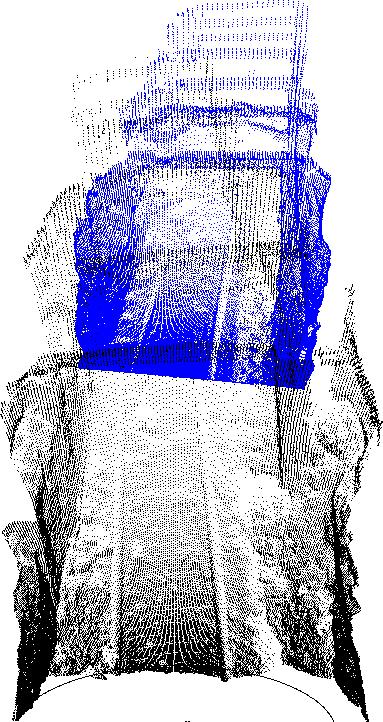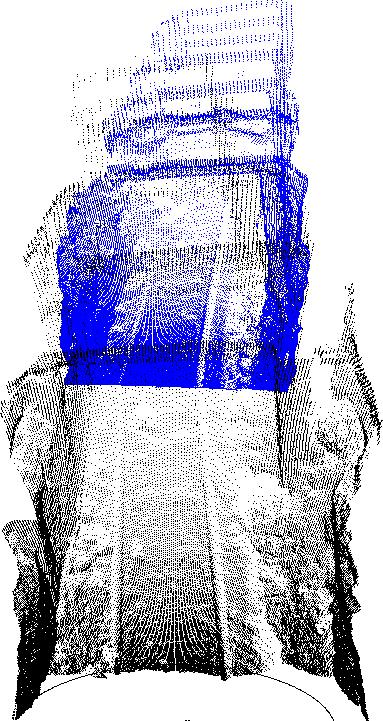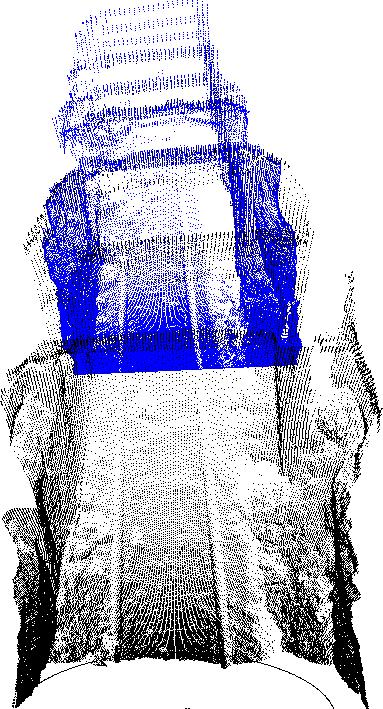The following method for registration of point sets is part of many publications, so only a short summary is given here. The complete algorithm was invented in 1992 and can be found, e.g., in [5]. The method is called Iterative Closest Points (ICP) algorithm.
Given two independently acquired sets of 3D points, ![]() (model set,
(model set,
![]() ) and
) and ![]() (data set,
(data set, ![]() ) which correspond to
a single shape, we want to find the transformation consisting of
a rotation
) which correspond to
a single shape, we want to find the transformation consisting of
a rotation ![]() and a translation
and a translation ![]() which minimizes the
following cost function:
which minimizes the
following cost function:
The ICP algorithm calculates iteratively a local minimum of
equation (1). In each iteration step, the algorithm
selects the closest points as correspondences ![]() and
calculates the transformation (
and
calculates the transformation (![]() ) for minimizing
equation (1). Fig. 2 shows three steps
of the ICP algorithm. Besl and McKay prove that the method
terminates in a minimum [5]. The assumption is that
in the last iteration step the point correspondences are correct.
) for minimizing
equation (1). Fig. 2 shows three steps
of the ICP algorithm. Besl and McKay prove that the method
terminates in a minimum [5]. The assumption is that
in the last iteration step the point correspondences are correct.
In each ICP iteration, the transformation is calculated by the
quaternion based method of Horn [15]: A unit
quaternion is a 4 vector
![]() , where
, where
![]() . It describes a
rotation axis and an angle to rotate around that axis. A
. It describes a
rotation axis and an angle to rotate around that axis. A ![]() rotation matrix
rotation matrix ![]() is calculated from the unit
quaternion according the the following scheme:
is calculated from the unit
quaternion according the the following scheme: ![]()
To determine the transformation, the mean values of the paired
points (centroid vectors) ![]() and
and ![]() are subtracted from
all points in
are subtracted from
all points in ![]() and
and ![]() , respectively, resulting in the sets
, respectively, resulting in the sets
![]() and
and ![]() . The rotation expressed as quaternion that
minimizes equation (1) is the largest eigenvalue of the
cross-covariance matrix
. The rotation expressed as quaternion that
minimizes equation (1) is the largest eigenvalue of the
cross-covariance matrix
with
![]() , ...After calculation the
rotation
, ...After calculation the
rotation ![]() , the translation is determined by
, the translation is determined by
![]() [15]. Fig. 2 shows two
3D scans in their initial, i.e., odometry-based pose, after 5
iterations, and the final pose. 40 iterations are needed to align
these two 3D scans correctly.
[15]. Fig. 2 shows two
3D scans in their initial, i.e., odometry-based pose, after 5
iterations, and the final pose. 40 iterations are needed to align
these two 3D scans correctly.



|